| Author |
Merit Badge Awardees - Woo-hoo Sisters!:  Farmgirl Sisterhood Merit Badge Awardees Farmgirl Sisterhood Merit Badge Awardees  |
|
MaryJane
Queen Bee
    
16783 Posts

MaryJane
Moscow
Idaho
USA
16783 Posts |
 Posted - Jan 11 2022 : 07:22:14 AM Posted - Jan 11 2022 : 07:22:14 AM

|
Rea Nakanishi (Lacey, #8284) has received a certificate of achievement in Farm Kitchen for earning a Beginner Level MaryJane's Better Butter Merit Badge!
“Before starting to work with any food product, always wash your hands, counters, and cooking tools. Wash hands in warm soapy water for at least 20 seconds.
Put unused cream in the fridge right away. Both unsalted butter and whipped butter should be refrigerated. However, if the temperature in your kitchen goes above 70 degrees Fahrenheit, in your kitchen, any butter (salted, unsalted and whipped) should go in the refrigerator to avoid spoilage. You can even store your butter in the freezer for up to a few months.
Two fun facts learned about butter: It takes 21.2 pounds of whole milk to make one pound of butter, and butter has been around for about 9000 years.
There are many was to make butter—a butter churn, hand shaken in a jar, food processor, or a hand mixer. I used the hand mixer because that is what I have available to use.
I love butter so this is a fun badge to work on!”
MaryJane, Farmgirl #1 Plowin' Thru ~ giving aprons a good wrap for 45 years and counting ~
 |
 |
|
|
MaryJane
Queen Bee
    
16783 Posts

MaryJane
Moscow
Idaho
USA
16783 Posts |
 Posted - Jan 11 2022 : 07:23:01 AM Posted - Jan 11 2022 : 07:23:01 AM

|
Rea Nakanishi (Lacey, #8284) has received a certificate of achievement in Farm Kitchen for earning an Intermediate Level MaryJane's Better Butter Merit Badge!
“It seems like the uses for buttermilk are almost endless. You can use buttermilk in biscuits, pancakes, breads, salad dressings and many more recipes.
Washing the butter takes out the casein which is a protien found in milk. You need to wash and knead, pressing cold water through the butter till the water is clear.
Sweet cream butter is a mild and creamy.
Cultured butter is a cream that they add lactic acid to start a fermentation process. This butter is more tangy in taste.”
MaryJane, Farmgirl #1 Plowin' Thru ~ giving aprons a good wrap for 45 years and counting ~
 |
 |
|
|
MaryJane
Queen Bee
    
16783 Posts

MaryJane
Moscow
Idaho
USA
16783 Posts |
 Posted - Jan 11 2022 : 07:24:31 AM Posted - Jan 11 2022 : 07:24:31 AM

|
Rea Nakanishi (Lacey, #8284) has received a certificate of achievement in Garden Gate for earning an Intermediate Level Rootin' Tootin Merit Badge!
“In my garden this year, I grew carrots and radishes. Both were from organic seed. For our holiday dinner, we had roasted carrots and radishes seasoned with herbs.
As for native root vegetables in my area, the only listing was carrots. The only place you would find them now is from a local farm.
Growing vegetables has always been a passion. so it was fun to do this project.”
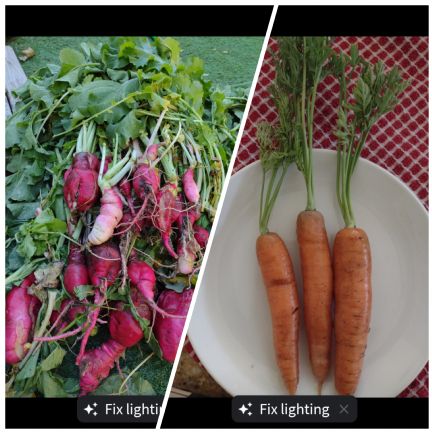
MaryJane, Farmgirl #1 Plowin' Thru ~ giving aprons a good wrap for 45 years and counting ~
 |
 |
|
|
MaryJane
Queen Bee
    
16783 Posts

MaryJane
Moscow
Idaho
USA
16783 Posts |
 Posted - Jan 11 2022 : 08:04:02 AM Posted - Jan 11 2022 : 08:04:02 AM

|
Aidan Murphy (aidanm, #7664) has received a certificate of achievement in Each Other for earning a Beginner Level Her-story Merit Badge!
“I researched Hillary Clinton. She was born in Chicago in 1947 and attended Yale for Law School, graduating in 1973. She of course is notable as not only former secretary of state but as the first female presidential nominee.
I chose Hillary because I was very interested to read her autobiography for the intermediate level of this badge. I read her official biography on govinfo.gov for the biography portion of this badge.”
MaryJane, Farmgirl #1 Plowin' Thru ~ giving aprons a good wrap for 45 years and counting ~
 |
 |
|
|
MaryJane
Queen Bee
    
16783 Posts

MaryJane
Moscow
Idaho
USA
16783 Posts |
 Posted - Jan 11 2022 : 08:06:16 AM Posted - Jan 11 2022 : 08:06:16 AM

|
Dawn Conrad (DawnC, #7297) has received a certificate of achievement in Stitching & Crafting for earning a Beginner Level Quilting Merit Badge!
“I enrolled in a Beginner Quilting Class in 2015. This class consisted of 3-four hour classes in which we each made a 41"x41" sampler quilt.
We were taught all the basics including measuring, fabric cutting, machine piecing, binding, machine quilting etc.
It was extremely fun and, at the time challenging (I had absolutely NO sewing or quilting experience.) It started an obsession and longing to learn more quilting history, techniques and even enter a couple competitions.”
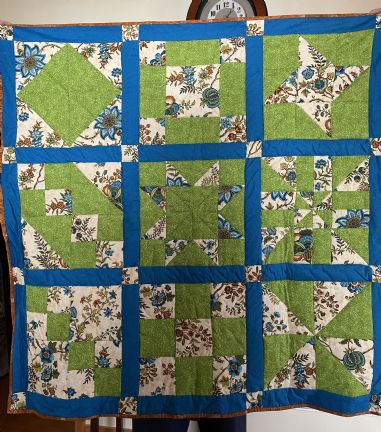
MaryJane, Farmgirl #1 Plowin' Thru ~ giving aprons a good wrap for 45 years and counting ~
 |
 |
|
|
MaryJane
Queen Bee
    
16783 Posts

MaryJane
Moscow
Idaho
USA
16783 Posts |
 Posted - Jan 11 2022 : 08:09:04 AM Posted - Jan 11 2022 : 08:09:04 AM

|
Dawn Conrad (DawnC, #7297) has received a certificate of achievement in Stitching & Crafting for earning an Intermediate Level Quilting Merit Badge!
“I've consistently enrolled in new quilting classes since completing my first beginner class to build on my knowledge and dive deeper into the cultural history of quilting in America. I have completed many "new" projects along the way, participated in multiple quilting retreats and have joined two different quilting groups.
I have learned a myriad of different quilting techniques such as traditional, scrappy, paper & picture piecing, modern, art/contemporary quilting. I have also sharpened my hand quilting & free motion domestic machine quilting skills. For the last five years, every Thursday from 9am–3p.m. I meet with fellow quilters in our group the SEW FINE QUILTERS and we spend the day teaching and learning from each other.”
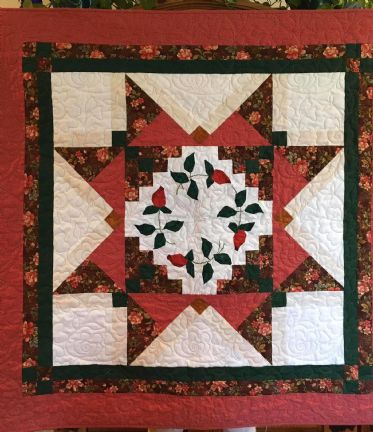
MaryJane, Farmgirl #1 Plowin' Thru ~ giving aprons a good wrap for 45 years and counting ~
 |
 |
|
|
MaryJane
Queen Bee
    
16783 Posts

MaryJane
Moscow
Idaho
USA
16783 Posts |
 Posted - Jan 11 2022 : 08:12:57 AM Posted - Jan 11 2022 : 08:12:57 AM

|
Dawn Conrad (DawnC, #7297) has received a certificate of achievement in Stitching & Crafting for earning an Expert Level Quilting Merit Badge!
“Free motion quilting, different techniques for finishing a quilt without bindings and making QAYG 'quilt as you go' quilt blocks are three of the newest techniques/patterns I have learned. I started my newest QAYG project 'Twighlight Dreaming' quilt when Covid hit us in 2019. I have tutored/taught many people (more than 5) how to quilt through workshops my two quilting groups give.
I love learning and executing new techniques & skills. 'Twighlight Dreaming' was a very ambitious QAYG project to do (picture attached.) I started in the spring of 2019 and finished October 2021. I also designed the border myself. I love teaching others new techniques and the basics through workshops. My two quilting groups provide to the public throughout the year.”
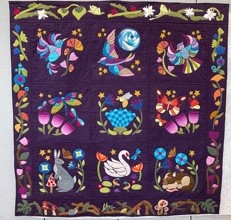
MaryJane, Farmgirl #1 Plowin' Thru ~ giving aprons a good wrap for 45 years and counting ~
 |
 |
|
|
MaryJane
Queen Bee
    
16783 Posts

MaryJane
Moscow
Idaho
USA
16783 Posts |
 Posted - Jan 14 2022 : 5:00:12 PM Posted - Jan 14 2022 : 5:00:12 PM

|
Cindy Kinion (AussieChick, #6058) has received a certificate of achievement in Stitching & Crafting for earning a Beginner Level Cross-Stitch Merit Badge!
“I chose to cross-stitch a 7 x 7 cm butterfly design for my beginner badge. The design included some simple instructions to get me started. I think I will make it into a birthday card for my friend, Pam, who loves butterflies.”
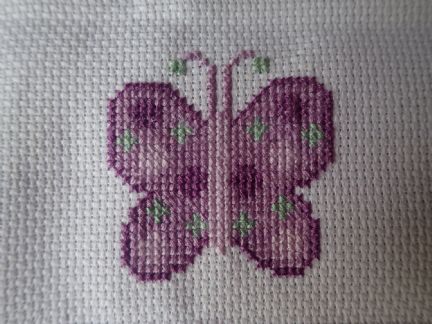
MaryJane, Farmgirl #1 Plowin' Thru ~ giving aprons a good wrap for 45 years and counting ~
 |
 |
|
|
MaryJane
Queen Bee
    
16783 Posts

MaryJane
Moscow
Idaho
USA
16783 Posts |
 Posted - Jan 14 2022 : 5:01:46 PM Posted - Jan 14 2022 : 5:01:46 PM

|
Cindy Kinion (AussieChick, #6058) has received a certificate of achievement in Cleaning Up for earning an Intermediate Level Leave It Better Than You Found It Merit Badge!
“My husband and I have always been mindful of picking up litter in public places. We used to have “emu-parades” when I was in primary school, which would mean we were all equipped with a trash bag and we’d go wandering around like emus picking up rubbish. Although we complained about it at the time, it was a good habit to develop and now I can’t walk past trash without making an effort to pick it up. Since achieving my beginner badge in July, my husband and I have made some purposeful trips to local areas to pick up trash (Ravensbourne National Park Day Use Area, Brisbane Valley Rail Trail, Pipeliner Park, Sandy Creek in Esk, and along our dirt road (Ravensbourne Dip Road).
Our local transfer station (which is free for residents), has recycling bins for glass and plastic bottles, bins for cardboard and newspaper, a green waste section, used oil deposit, and scrap metal section. If we find car tires, they are recycled at the Esk Transfer Centre.”
MaryJane, Farmgirl #1 Plowin' Thru ~ giving aprons a good wrap for 45 years and counting ~
 |
 |
|
|
MaryJane
Queen Bee
    
16783 Posts

MaryJane
Moscow
Idaho
USA
16783 Posts |
 Posted - Jan 14 2022 : 5:02:42 PM Posted - Jan 14 2022 : 5:02:42 PM

|
Cindy Kinion (AussieChick, #6058) has received a certificate of achievement in Farm Kitchen for earning an Expert Level Get It Together Merit Badge!
“I must say, I wasn’t very disciplined with sharpening my kitchen knives until I started working on this badge. I started by reading about the requirements for sharpening my knives. I researched the website www.cheftoys.com. Interestingly enough, I found out that steel rods are only meant for honing. These will not sharpen the blade! They will smooth out minor imperfections that occur to the knife between major cuts and hone it back to sharp. This will last until the knife becomes dull and a honing steel will be ineffective. Rather, what is required for sharpening is a “sharpening steel”. The difference is that sharpening steel is covered with a ceramic or diamond coating. That gives it the ability to remove metal off your blade’s edge, restoring its sharpness.
I have one automatic pull sharpener. They’re a great option for quick and easy sharpening of your daily knives that are used for a variety of tasks. These are inexpensive devices that can quickly give knives a new life at a moment’s notice.”
MaryJane, Farmgirl #1 Plowin' Thru ~ giving aprons a good wrap for 45 years and counting ~
 |
 |
|
|
MaryJane
Queen Bee
    
16783 Posts

MaryJane
Moscow
Idaho
USA
16783 Posts |
 Posted - Jan 14 2022 : 5:03:34 PM Posted - Jan 14 2022 : 5:03:34 PM

|
Cindy Kinion (AussieChick, #6058) has received a certificate of achievement in Garden Gate for earning an Expert Level Water Management Merit Badge!
“Drip irrigation systems are much more efficient, using 20 to 50 percent less water than normal sprinkler systems. Drip irrigation goes straight into the ground and isn't susceptible to run-off, drift, or evaporation. There is the initial outlay of cost to consider when setting up a drip irrigation system, but efficient use of water is worth it in the long run.
We don’t have a drip irrigation system, but we do collect our grey water for use on the garden. Because we live in a rural area, we are not connected to city water which means we have rainwater tanks to collect our drinking water and water for daily use. Our grey water is expelled via a poly pipe to the yard and I can move the pipe around to water the yard and, during dry times, I can collect it in buckets for deep watering of my fruit trees.
Three additional methods that I use to better manage and reduce my garden water consumption include: Appropriate plantings that are best suited to our environment (eg. drought-tolerant native plants); heavy mulching to retain soil moisture; less frequent deep waterings, particularly of trees (this also helps to encourage deeper root growth).”
MaryJane, Farmgirl #1 Plowin' Thru ~ giving aprons a good wrap for 45 years and counting ~
 |
 |
|
|
MaryJane
Queen Bee
    
16783 Posts

MaryJane
Moscow
Idaho
USA
16783 Posts |
 Posted - Jan 14 2022 : 5:04:35 PM Posted - Jan 14 2022 : 5:04:35 PM

|
Cindy Kinion (AussieChick, #6058) has received a certificate of achievement in Make It Easy for earning a Beginner Level Leatherworking Merit Badge!
“For the art of leatherworking, you will require the following equipment:
• The most obvious requirement is, of course, leather.
• Thread options are endless, but you’ll likely want synthetic thread over a natural thread. Synthetic threads won’t biodegrade over time like sinew or cotton threads, ensuring your project a longer life.
• Cutting leather is a fundamental part of producing leather goods and there are a few different options out there to get the job done, so your choice will boil down to personal preference. The most common tools used are a standard utility knife, a rotary cutter, or a round knife. Each option will provide a different cutting experience. Xacto knives and box cutters are even the choices of the most well-respected leatherworkers.
• A Cutting Mat is essential to make precise, clean cuts, and to protect your workbench. You can pick up a self-healing cutting mat from most stationary stores.
• Unlike textiles, you can’t accurately stitch through leather without first creating stitch holes. In order to do so, however, you need a Diamond Chisel, which is used to punch those stitching holes through pieces of leather. Coming in different sizes and prong widths, Diamond Chisels are placed on top of the leather and struck with a mallet to drive the tool through a piece of hide.
• In basic leather work, a hammer is used to strike punches and rivet setters. A plastic hammer is recommended to ensure clean strikes that won’t scratch or damage your kit.
• The Stitching Awl is used to widen or create stitching holes, and carry the stitching thread through the holes.
• To stitch up your leather goods, suitable needles must be acquired. Needles used for leather work are typically dull, as the stitching holes are usually pre-punched with a diamond chisel. The eye of the needle must also be large enough for the heavy, waxed threads used to stitch leather goods.
• Skiver: Sometimes, leather will need to be ‘skived’ to make it thinner for certain parts of the production process, like folding. Skivers vary in appearance from open-blade to an almost potato-peeler construction, but each variant on this tool will simply use a blade to pare down the surface of the leather.
• An Edge Beveller is a small tool with a sharpened notch that is used for trimming and finishing the edges of leather to round them off.
• Groover: This adjustable tool is used to create a straight channel where stitching holes can be punched. Additionally, creating such a channel means the stitches will not stick up from the leather, reducing overall friction and improving the durability of your leather goods.
• Hole punches: These metal pegs are used to punch holes in leather for hardware like rivets or belt holes. Again, punches are used in conjunction with a hammer or mallet to drive the tool through the leather.
I have never done any leather work before, so I would start with something small. Small accessories like wallets are reportedly a good way to start your new hobby and, depending on the style, will usually work best with full grain leather. Luggage tags or monogrammed leather keychains are another simple project. For those, I would need to purchase some leather stamps.
Tools that are left to sit tend to rust. You can start by wire brushing those to remove any rust. Then there is the technique of sharpening and polishing blade edges using the stropping method - jewellers rouge is rubbed onto a scrap piece of leather, then the blade is rubbed onto the polishing compound.”
MaryJane, Farmgirl #1 Plowin' Thru ~ giving aprons a good wrap for 45 years and counting ~
 |
 |
|
|
MaryJane
Queen Bee
    
16783 Posts

MaryJane
Moscow
Idaho
USA
16783 Posts |
 Posted - Jan 14 2022 : 5:06:06 PM Posted - Jan 14 2022 : 5:06:06 PM

|
Cindy Kinion (AussieChick, #6058) has received a certificate of achievement in Stitching & Crafting for earning an Intermediate Level Buttoned Up Merit Badge!
“I collected all of my excess white and clear buttons and made a bracelet. I have worn my new bracelet a few times now and have already had a few compliments from people.”
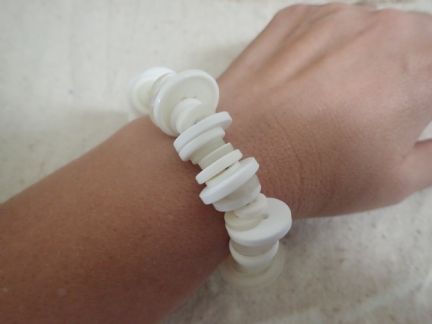
MaryJane, Farmgirl #1 Plowin' Thru ~ giving aprons a good wrap for 45 years and counting ~
 |
 |
|
|
MaryJane
Queen Bee
    
16783 Posts

MaryJane
Moscow
Idaho
USA
16783 Posts |
 Posted - Jan 14 2022 : 5:07:45 PM Posted - Jan 14 2022 : 5:07:45 PM

|
Cindy Kinion (AussieChick, #6058) has received a certificate of achievement in Farm Kitchen for earning an Intermediate Level Kitchen Renegade Merit Badge!
“There isn’t a lot of equipment required for most fermentation. The vessels are probably to most important. A cylindrical shape is easiest. An old-fashioned heavy ceramic crock is best, but you can also use a wide-mouth glass jar. Just ensure that there are no cracks in your crock. If you use plastic, you must ensure that it's food-grade. And do not ferment in metallic containers, which can react with the salt as well as the acids produced by fermentation.
Good quality water is also essential. Do not use water that is heavily chlorinated for fermentation projects. Chlorine is used in water precisely because it kills microorganisms. If you can smell or taste chlorine in tap water, either boil it to evaporate the chlorine before using the water, or use water from another source.
The main difference between vegetables left to rot and those destined for delicious fermentation is usually salt. Vegetables ferment best under the protection of brine. Brine is simply water with salt dissolved in it. In some ferments, such as sauerkraut, the salt is used to draw water out of the vegetables, thus creating intense vegetable juice brine. In other ferments, such as cucumber pickles, a brine solution is mixed and then poured over the vegetables. Brine serves as protection against the growth of putrefying microorganisms and favors the growth of the desired strains of bacteria.
You will also need a cover or a weight to help keep the vegetables submerged in the brine. A large plate that fits inside the crock can work. I generally just use a smaller jar that fits inside the mouth of my larger crock. You could also use a zip-lock bag filled with brine to weight down the ferment in the jar.
Finally, it helps to have a cloth cover to put over the whole crock. This keeps dust and flies out.
I have tried a few different vegetable ferments. I thought that the first sauerkraut that I made was too salty, so on the next attempt I used less salt which resulted in a much better taste. I will usually sample the sauerkraut after 3 days. I will usually transfer it to the fridge at this time and then eat it over the course of a few weeks.
I have also made pickled beetroots which were delicious and I also made pickled carrots and cucumbers. These vegetables had the brine added to them. The beetroots were boiled in the brine and the carrots and cucumbers simply had it added and were then left to sit for several hours before serving.”
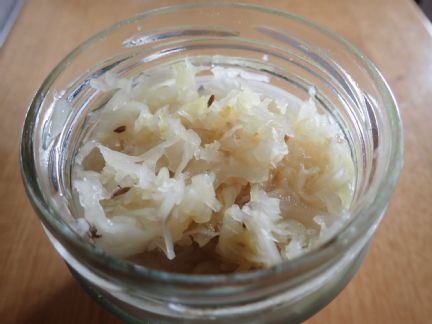
MaryJane, Farmgirl #1 Plowin' Thru ~ giving aprons a good wrap for 45 years and counting ~
 |
 |
|
|
MaryJane
Queen Bee
    
16783 Posts

MaryJane
Moscow
Idaho
USA
16783 Posts |
 Posted - Jan 14 2022 : 5:08:37 PM Posted - Jan 14 2022 : 5:08:37 PM

|
Cindy Kinion (AussieChick, #6058) has received a certificate of achievement in Farm Kitchen for earning an Expert Level Kitchen Renegade Merit Badge!
“Our favorite way to eat sauerkraut is in a reuben sandwich. I use sourdough (made locally by our friend, Caz), pastrami, sauerkraut, and peri mayonnaise. This is then grilled and served for breakfast or lunch. Yum!
Another way that we enjoy sauerkraut is served as a side with grilled sausages and mashed potatoes. Maybe it's our German heritage coming out!”
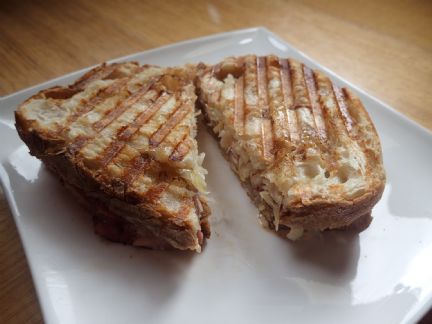
MaryJane, Farmgirl #1 Plowin' Thru ~ giving aprons a good wrap for 45 years and counting ~
 |
 |
|
|
MaryJane
Queen Bee
    
16783 Posts

MaryJane
Moscow
Idaho
USA
16783 Posts |
 Posted - Jan 14 2022 : 5:10:17 PM Posted - Jan 14 2022 : 5:10:17 PM

|
Cindy Kinion (AussieChick, #6058) has received a certificate of achievement in Outpost for earning a Beginner Level Buzzin' Around Merit Badge!
“I sort of had the help of my husband for this merit badge. He has a chainsaw that he uses to cut firewood every season and to clear some of the trails around our area (he is involved in the Munro Tramway Historical Group and they have walking trails that they maintain as part of the group activities). He has previously taught me how to use the chainsaw and I have, on the odd occasion, taken the reigns and cut some fire wood.
We have a STIHL M5 181 chainsaw. The manufacturer's description states “A light and low-vibration chainsaw. Wide range of features such as long-life air filter system and STIHL anti-vibration system. Great for cutting firewood and felling small trees. Up to 20 % less fuel consumption and up to 70 % lower emissions compared with STIHL 2-stroke engines of the same power output without 2-MIX technology”. I do like that it is fairly light weight for me to manage.
Other equipment that we have when using our chainsaw includes: ear muffs, safety glasses, hard hat, Blundstone work boots, gloves, fuel container, 2-stroke engine oil, chain oil, filing kit, and safety vest.”
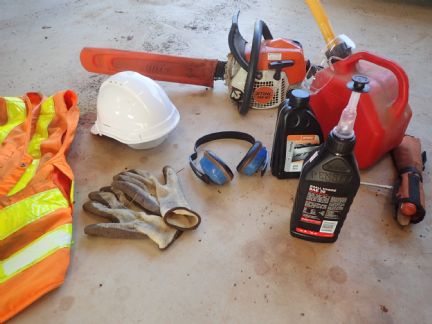
MaryJane, Farmgirl #1 Plowin' Thru ~ giving aprons a good wrap for 45 years and counting ~
 |
 |
|
|
MaryJane
Queen Bee
    
16783 Posts

MaryJane
Moscow
Idaho
USA
16783 Posts |
 Posted - Jan 14 2022 : 5:11:22 PM Posted - Jan 14 2022 : 5:11:22 PM

|
Cindy Kinion (AussieChick, #6058) has received a certificate of achievement in Outpost for earning an Intermediate Level Buzzin' Around Merit Badge!
“I watched the suggested video on Chainsaw Safety designed especially for women. This, together with the coaching from my husband helped me prepare for some chainsaw action. So far, I'm only cutting up firewood and felling smaller branches.”
MaryJane, Farmgirl #1 Plowin' Thru ~ giving aprons a good wrap for 45 years and counting ~
 |
 |
|
|
MaryJane
Queen Bee
    
16783 Posts

MaryJane
Moscow
Idaho
USA
16783 Posts |
 Posted - Jan 14 2022 : 5:12:19 PM Posted - Jan 14 2022 : 5:12:19 PM

|
Cindy Kinion (AussieChick, #6058) has received a certificate of achievement in Outpost for earning an Expert Level Buzzin' Around Merit Badge!
“Well, here I am today - cutting up some firewood. I'm getting a lot more confident operating the chainsaw. The photograph shows some of the safety gear that I wear while operating the chainsaw.”
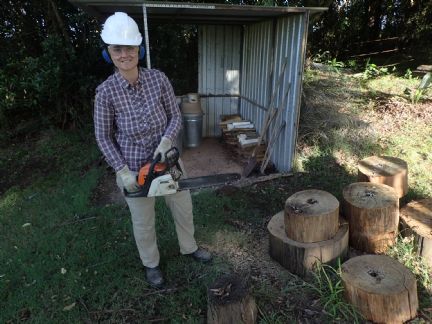
MaryJane, Farmgirl #1 Plowin' Thru ~ giving aprons a good wrap for 45 years and counting ~
 |
 |
|
|
MaryJane
Queen Bee
    
16783 Posts

MaryJane
Moscow
Idaho
USA
16783 Posts |
 Posted - Jan 14 2022 : 5:13:40 PM Posted - Jan 14 2022 : 5:13:40 PM

|
Cindy Kinion (AussieChick, #6058) has received a certificate of achievement in Garden Gate for earning an Expert Level Weather Merit Badge!
“We've kept a rainfall chart every year since we have lived in Ravensbourne. Growing up on a farm, the weather, and the local rainfall, were always hot topics of conversation and every drop is vital in a land prone to long periods of drought. The rain water is our only water source on our property, so we treasure every drop.
In addition to the rainfall, I also recorded daily temperatures (lows and highs), times of sunrise and sunset, humidity and cloud formation, moon phase, wind speed and direction, UV index, and fire danger rating. A lot of this information is on our community radio station, but my husband also has a weather app on his phone that gives daily weather information.
Many years ago our friends from Germany gave us a German weather house. The house has two doors side by side. The left side has a girl, the right side a boy. The girl comes out of the house when the weather is sunny and dry, while the boy comes out to indicate rain. It is actually very accurate. The weather house functions as a hygrometer embellished by folk art. The male and female figures ride on a balance bar, which is suspended by a piece of catgut. The gut relaxes or shrinks based on the humidity in the surrounding air, relaxing when the air is wet and tensing when the air is dry. This action swings one figure or the other out of the house depending on the humidity. At the time that the attached photograph was taken, it was 82% humidity, so the boy was out of the door to the maximum point.”
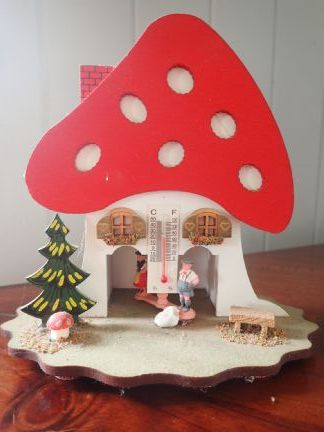
MaryJane, Farmgirl #1 Plowin' Thru ~ giving aprons a good wrap for 45 years and counting ~
 |
 |
|
|
MaryJane
Queen Bee
    
16783 Posts

MaryJane
Moscow
Idaho
USA
16783 Posts |
 Posted - Jan 14 2022 : 5:14:43 PM Posted - Jan 14 2022 : 5:14:43 PM

|
Cindy Kinion (AussieChick, #6058) has received a certificate of achievement in Garden Gate for earning a Beginner Level Permaculture Merit Badge!
““Permaculture is a design system for the creation of socially, economically and ecologically sustainable settlements, whether in rural areas or metropolitan cities” (Bill Mollison). Bill Mollison and David Holmgren created the Permaculture design system in the late 1970s while living in Hobart, Tasmania. Bill was instrumental in setting up Tagari Publications, which produced books on Permaculture, and established the Permaculture Institute, originally in Tasmania, then at Tyalgum in northern NSW.
Permaculture developed as a do-it-yourself approach to making households into energy efficient, food producing and resource conserving places. At the same time Permaculture proposes that we move beyond the household—that community involvement is a means to self-help, improved quality of life and sustainability.
Permaculture is the development and monitoring of a productive, diverse and environment-friendly ecosystem built on hybrid biological and technical closed loops. A closed loop is a cyclic process where the wastes are reintegrated as resources in a dynamic system (thermodynamically) energy efficient. Everything is recycled, waste is eliminated by design and transformed in resources, processes are clear and energy saving, defined for little maintenance. Functions are designed with recycling in mind, with recycling capabilities (capture incoming flows, Reduce, Reuse, Repair, Recycle) and self-recycling of the function itself.
Permaculture gardens serve many functions. Rather than limit the garden to only one use, permaculture gardens employ a variety of uses. A permaculture garden provides food and medicinal crops, wildlife habitats, crafting materials, an attractive appearance, and a private, relaxing atmosphere throughout every season.
There is no need for pesticides in a permaculture garden. Water features often encourage beneficial insects, birds, frogs, and other small wildlife creatures, and many of these will feed on pests in the permaculture garden. Companion plantings also help keep insect and other pest problems to a minimum. Permaculture gardens require less maintenance. Once a permaculture garden has established itself, you do nothing but water and harvest crops or add occasional mulch.
There are several permaculture methods. A lasagna garden is merely adding the step of arranging a series of layers of organic matter that decompose over time and create a fertile garden bed for you instead of forcing one into existence temporarily by roto-tilling.
Hügelkultur is a centuries-old, traditional way of building a garden bed from rotten logs and plant debris. These mound shapes are created by marking out an area for a raised bed, clearing the land, and then heaping up woody material (that's ideally already partially rotted) topped with compost and soil.
Rotational grazing involves moving livestock through a series of paddocks so when they have finished grazing the last paddock in the series, the first paddock has recovered to allow the rotation to recommence. A well-designed rotational grazing system can also prevent uneven grazing across the paddock.”
MaryJane, Farmgirl #1 Plowin' Thru ~ giving aprons a good wrap for 45 years and counting ~
 |
 |
|
|
MaryJane
Queen Bee
    
16783 Posts

MaryJane
Moscow
Idaho
USA
16783 Posts |
 Posted - Jan 14 2022 : 5:15:37 PM Posted - Jan 14 2022 : 5:15:37 PM

|
Cindy Kinion (AussieChick, #6058) has received a certificate of achievement in Garden Gate for earning a Beginner Level Horse Dreams Merit Badge!
“We see quite a lot of horses in our area. Being largely a farming community, horses are often used for cattle mustering and as a means of generally getting around the farm. There are a few horse breeders and some properties that have agistment arrangements. Camp-drafting is a very popular sport at the local showgrounds. The Brisbane Valley Rail Trail is also a popular place for riders to take their horses. When I run along the trail, I get to meet some of the horses up close and personal, both those riding the trail and those that are fenced in neighboring properties.
My friend, Mikkalea, has 8 horses on her property, so I asked her about her horses. Mikkalea and her sister use their horses for camp-drafting. She said that all of her horses are “warm-bloods.” Horses with a pedigree that includes cold and hot-blooded horses are warmbloods. The original warmblood breeds were offspring of large coach horses crossed with smaller Arabians and Thoroughbreds. Warmbloods are typically intelligent, have calm temperaments, and are exceptional athletes. Warmblooded horses trace their roots to healthy, high-strung horses that were typically hard to handle. These hot horses had desired athletic ability but needed a calmer demeanor, so a cold-blooded horse, often large draft breeds, was introduced to their bloodline. The result is a larger athletic horse with a calm temperament that is smart and easy to train. Thus, over centuries of selective crossbreeding, you end up with a horse with the best of all forms of “blood.” The classification has little to do with their body temperatures. In fact, it is their temperament rather than the temperature of their blood that is instead linked to the classification.
Most people that follow horse competitions are familiar with warmbloods. They are always at the top of the contender boards. These crossbred horses have good bone mass, solid muscles, cold-blooded and hot-blooded speed, and capacity in competitions such as show jumping, etc.”
MaryJane, Farmgirl #1 Plowin' Thru ~ giving aprons a good wrap for 45 years and counting ~
 |
 |
|
|
MaryJane
Queen Bee
    
16783 Posts

MaryJane
Moscow
Idaho
USA
16783 Posts |
 Posted - Jan 14 2022 : 5:16:29 PM Posted - Jan 14 2022 : 5:16:29 PM

|
Cindy Kinion (AussieChick, #6058) has received a certificate of achievement in Farm Kitchen for earning a Beginner Level Cheesemaking Merit Badge!
“No matter what type of milk you use for cheese making, it must be of the highest quality. Always use the freshest milk possible. If it comes from the supermarket, do not open the container until you are ready to start. This will prevent possible contamination from bacteria in the air. Above all, if the milk tastes sour or “off”, throw it away—the cheesemaking process will not make your milk taste better! When purchasing milk, remember that 1 gallon yields 1 pound for hard cheeses or 2 pounds for soft cheeses. Yields from goat’s milk and nonfat milk are lower, and the yield from sheep’s milk is higher.
Raw milk comes directly from a farm animal and is filtered and cooled before use. It is not pasteurized, so it has a higher vitamin content than heat-treated milk. Raw milk brings out the fullness and richness of flavours, and it has the added advantage of bringing the subtleties of pasturing and the diet of the animal into your final cheese. Raw milk contains natural flora, many of which are very useful in cheese making. It may also contain harmful bacteria, known as pathogens, that can cause disease in humans. Pathogens that may be found in milk include Mycobacterium, which causes tuberculosis; Brucella, which causes brucellosis; and Salmonella, which causes salmonellosis. Typically, salmonella outbreaks are caused by lack of cleanliness in factories, where the thinking is that “pasteurization will take care of it.” If you consume raw milk or use raw milk to produce cheese that is aged fewer then 60 days (this includes almost all fresh cheeses), you must be absolutely certain that there are no pathogens in the milk. Never use milk from an animal that is suffering from mastitis or receiving antibiotics, which will destroy the helpful bacteria that are essential in making cheese.
Most home cheesemaking failures can be attributed to one or more of the following:
• Poor milk-handling procedures
• Poor sanitizing of equipment
• Cross-contamination of the cheese with foreign bacteria at any stage during the process
While it may sound daunting, keeping your work area sanitized can greatly reduce the risk of contamination. Follow these few simple steps to clean and sanitize your work area:
1. Fill an atomizer with water and add about 1 capful of household bleach.
2. Spray mixture onto countertops, stove, and sink, if using.
3. Wait one full minute, then wipe surfaces clean using paper towels.
4. Keep this spray and a roll of paper towels close by during the cheesemaking process, to wipe up spills or to re-wipe surfaces between steps.
Bleach is by far the most efficient way to sanitize equipment. However, if using bleach is not an option, fill an atomizer with 1 cup of white vinegar, 3 cups of water and a few drops of lavender, tea tree, or peppermint essential oil.
Metal utensils are easy to sterilize by boiling. Follow these simple steps:
1. Wash pots and all utensils in very hot, soapy water.
2. Rinse them in clear, cold water.
3. Fill cheese pot about half full of clean water; put in all metal utensils.
4. Put the pot on the stove and heat water to just boiling; turn off heat and cover.
We make cheese, for the most part, by the addition of bacterial starter cultures. These bacteria are living entities and do a specific job of consuming lactose and creating, as a waste product, lactic acid. This requires us to consider temperature for two reasons, the first being keeping the bacteria alive – a wide temperature range—the second being a focus on their productivity, which is a narrow range of temperatures at which bacteria are most efficient at lactic acid production. The most vital piece of equipment to help us regulate temperature is, of course, the thermometer. There are many of them on the market and it is not a tool that you need to get from a specialist cheese kit supplier. It’s best to use a thermometer that can clip onto the side of the pan if using a dial type. Digital thermometers tend to give a quicker read out so a clip is less essential, but having one means you can use it ‘hands free’ which is a benefit. The temperature range used for cheese making is quite narrow, so a thermometer that ranges from 0C to 100C will be suitable The more important feature your thermometer needs to have is 1C / 2F marker points because to make good cheese we do need to control the temperature of our milk or curds to an accuracy of 1C.
Some problems that occur with starter preparation include a starter that tastes sharply acidic, or slightly metallic – it may mean that it has overripened. Next time, use a little less starter, or incubate the milk at 70 F instead of 72 F for mesophilic culture or at 108 F instead of 110 F for thermophilic culture. If the starter won’t coagulate, it may be because of any of the following: (a) the temperature dropped below 72 F during the ripening period; (b) the inoculating culture didn’t contain live bacteria; (c) the milk contained antibiotics; (d) while cleansing your utensils, you used bleach or a strong detergent and didn’t rinse thoroughly. Residual amounts of either can halt bacterial action. If you find bubbles in your finished starter culture, discard it. Bubbles may mean that the milk was not properly sterilised in the canning-jar step. Gas-producing organisms, such as yeasts and coliform bacteria, manufacture bubbles. They are present in a starter because of faulty preparation techniques.
I used the book "Home Cheese Making" by Ricki Carroll for my cheesemaking information and recipes. I first tried the easy buttermilk recipe which used 1 quart pasteurized whole milk and 1 packet of direct-set buttermilk starter. It took about 12 hours to set. I then used by buttermilk to make the recipe for Avocado Buttermilk Dressing.”
MaryJane, Farmgirl #1 Plowin' Thru ~ giving aprons a good wrap for 45 years and counting ~
 |
 |
|
|
MaryJane
Queen Bee
    
16783 Posts

MaryJane
Moscow
Idaho
USA
16783 Posts |
 Posted - Jan 14 2022 : 5:17:51 PM Posted - Jan 14 2022 : 5:17:51 PM

|
Cindy Kinion (AussieChick, #6058) has received a certificate of achievement in Cleaning Up for earning an Expert Level Water Conservation Merit Badge!
“We have been averaging approx. 100L per person per day in our household of 2.
I researched some of the higher water consumption activities in the home and discovered that:
• Toilets with dual flush - 3 liters per half flush, 6 or 4.5 liters per full flush (depending on the toilet)
• Shower: 6 to 11 liters per minute;
• Brushing teeth with water running - 3 liters per minute
• Shaving with water running - 3 litters per minute
• Washing dishes by hand – 15 liters per half-filled sink
• Drinking: 2 liters per person per day
• Washing clothes: washing machine e.g. 6kg load capacity - 30 liters per load (6 star WELS rated), 88 litters per load (3 star WELS rated), older machines up to 180 liters per load
• Watering gardens: with a hose - 15 liters per minute; with a sprinkler - 9–15 litters per minute
Our only water source is rainwater that we collect in 2 large rainwater tanks. If these get full, we pump excess water into a third tank that is gravity fed to water my garden. We also use recycled grey water for watering the garden and fruit trees. We do not water the lawn at all and I mulch the gardens heavily to reduce the need for excess watering of plants. Choosing native plants that are tolerant to our weather conditions has also made a huge difference.
We turn taps off when brushing teeth and my husband shaves while in the shower. We have a 4-minute timer in the shower to know how long we have been in there. We have a toilet with the half-flush option which will use 3L per flush versus up to 6L per full flush.”
MaryJane, Farmgirl #1 Plowin' Thru ~ giving aprons a good wrap for 45 years and counting ~
 |
 |
|
|
MaryJane
Queen Bee
    
16783 Posts

MaryJane
Moscow
Idaho
USA
16783 Posts |
 Posted - Jan 14 2022 : 5:20:11 PM Posted - Jan 14 2022 : 5:20:11 PM

|
Cindy Kinion (AussieChick, #6058) has received a certificate of achievement in Outpost for earning a Beginner Level Wild Game Merit Badge!
“Field & Game Australia members participate in a variety of ethical hunting activities. Australia offers a diverse range of game species such as duck, geese, quail and deer. These species are harvested for the table, allowing hunters to stock up on great free-range food, with low food mileage. Field & Game Australia members also volunteer their time to assist in pest animal control programs on public, freehold and private land. Private landholders, primary producers, and government agencies are among those assisted by Field & Game Australia’s conservationist hunters. Pest animal species hunted in Australia include foxes, feral cats, rabbits, wild pigs, buffalo, wild goats, wild dogs and a variety of introduced pest bird species (such as Indian Mynahs). Not all are suitable for consumption, but some pest animals are extremely good to eat—an added bonus to the satisfaction of removing pest and introduced animals from our landscape.
A hunter needs to understand and follow the principles of ethical hunting and SSAA (Sporting Shooters Association Australia) members are required to abide by the Hunting Code of Ethics. They should also always display an appreciation and adherence to sustainable wildlife management practices and obey all specific game and hunting laws. Two of the most popular ways to get involved with hunting as an SSAA Queensland member are through the Conservation & Wildlife Management or the Farmer Assist Program.
Only pest animals, including Feral Pigs, Feral Cats and Dogs, Hares, Foxes, Rabbits, Feral Goats, Chital, Fallow and Hog Deer, and Dingoes, may be hunted in Queensland. There are other types of wild game, including kangaroos and emus. The macropods that you are allowed to harvest in Queensland are the eastern grey kangaroo, red kangaroo and wallaroo. It is a condition of all licences that you only sell to licensed dealers, processors and tanneries and that you correctly tag your harvested macropods.
Hunting is restricted to privately owned land, with the landholder’s express permission. Hunting on Crown Land (including in State Forests and National Parks) is NOT PERMITTED in Queensland.
SSAA CODE OF ETHICS
• Having first obtained a landholder’s permission to shoot on their property, members should consider themselves to be invited guests;
• Members must obey the rules of safe firearms handling and diplomatically yet firmly insist others to do the same;
• Members must obey relevant hunting laws and regulations and diplomatically yet firmly insist others do the same;
• Members should support game conservation programs and the sustainable use of wildlife;
• Most importantly, members must pass on to others, including youngsters, the proper attitudes towards game management and conservation and the skills of safe firearms ownership, which are the hallmarks of the sporting shooter.
Safe Handling of Wild Game Meats:
1. Remove the intestines, lungs, liver and heart as soon after the kill as possible.
2. Keep the carcass clean by getting it off the ground as quickly as possible and by using clean utensils during dressing.
3. Cool the carcass quickly and keep it cool during processing and transport.”
MaryJane, Farmgirl #1 Plowin' Thru ~ giving aprons a good wrap for 45 years and counting ~
 |
 |
|
|
MaryJane
Queen Bee
    
16783 Posts

MaryJane
Moscow
Idaho
USA
16783 Posts |
 Posted - Jan 14 2022 : 6:16:16 PM Posted - Jan 14 2022 : 6:16:16 PM

|
Allison Clark (Allison Clark, #8292) has received a certificate of achievement in Stitching & Crafting for earning an Expert Level Homespun Christmas Merit Badge!
“Last year I finished the intermediate level. I gave the tree to a senior citizen who loved it. This year I did my own tree. I made all the ornaments and all my gifts. I had fun making gifts. One of the gifts that I made was a knitted shawl for my daughter-in-law. She loved it. This was so much fun to do.”

MaryJane, Farmgirl #1 Plowin' Thru ~ giving aprons a good wrap for 45 years and counting ~
 |
 |
|
Merit Badge Awardees - Woo-hoo Sisters!:  Farmgirl Sisterhood Merit Badge Awardees Farmgirl Sisterhood Merit Badge Awardees  |
|
|
|